Romero House has long been a place of welcome and hope in the heart of Toronto for refugees from around the world. As it celebrates its 25th anniversary this year, we chat with its founder, Mary Jo Leddy, who holds a PhD in Philosophy from the University of Toronto.
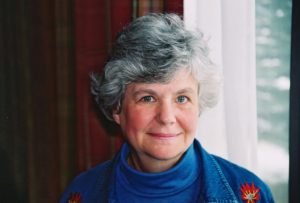 Besides living and working at Romero House, Mary Jo Leddy is an author, theologian, social activist and adjunct professor at Regis College, University of Toronto. In 1975, she was founding editor of the Catholic New Times, an independent Catholic newspaper that published bi-weekly from Toronto until 2006. Leddy has received many honorary doctorates and awards over the years, including the Human Relations Award of the Canadian Council of Christians and Jews, the Massey College Clarkson Laureate for Leadership in Social Policy, and the Order of Canada.
Besides living and working at Romero House, Mary Jo Leddy is an author, theologian, social activist and adjunct professor at Regis College, University of Toronto. In 1975, she was founding editor of the Catholic New Times, an independent Catholic newspaper that published bi-weekly from Toronto until 2006. Leddy has received many honorary doctorates and awards over the years, including the Human Relations Award of the Canadian Council of Christians and Jews, the Massey College Clarkson Laureate for Leadership in Social Policy, and the Order of Canada.
Leddy is a sought-after speaker, thanks to her keen insights and many rich life experiences. She recently was invited to speak at the Congress of Humanities and Social Sciences 2016, which was held at the University of Calgary. This annual event is Canada’s largest gathering of academics, researchers, policy makers and practitioners across many disciplines. Kolbe Times was delighted to sit down over coffee with Mary Jo Leddy during the Congress.
Kolbe Times: In celebration of Romero House’s quarter century of service to refugees, this is a great time to look back at its beginnings. How did Romero House come to be?
Mary Joe Leddy: Romero House wasn’t planned. Depending on your theology, it was either providence or accident! I had never thought of working with refugees. But a friend of mine had been working as a night manager in a home for refugees run by the Congregation of Christian Brothers. At that time I was on the Board of Catholic New Times, and we needed a new editor. This friend of mine was the person we wanted for the job, but when we talked to her she said she had this night manager job, and she would have to find a replacement before she could start work as our editor. I asked her what was involved with the job, and she said, “You just have to be there in the evening and sleep there and make sure the place doesn’t burn down.” I said, “I can do that!” So I agreed to take over her job on the night shift at this refugee house for a month until they could find someone else to take the job permanently.
At that particular time, there was a remarkable group of refugees living there, mostly women and children from Eritrea and Somalia. A few things struck me. One was how much I enjoyed being with them! And it wasn’t an effort – I wasn’t really doing anything. But I also noticed that the way it was being run by the Brothers was the shelter/social worker kind of model. The Brothers did a lot of good – they sponsored many people who came to Canada. But I could see that the way the refugees were during the day with the staff was very different from the way they were in the evening when the staff wasn’t there. In the evening, these women would make tea, open their doors, and visit with each other. They were having fun, and they were so dignified. I loved having tea with them and just being with them. It’s hard to explain, but for me, as a Christian, it felt like the gospel walked off the page every evening. My friends who came to visit me saw the same thing. Anyways, when we found out the Brothers were planning to close the House, we started thinking that maybe we could continue this, but not with the same model – with a different way of being with people.
Kolbe Times: Tell us about this new model and how it’s worked out.
Mary Jo Leddy: Well, we didn’t really have much of a plan at the start, but through our conversations a vision developed. We decided that the sense of community was the important thing, to have apartments with no internal locks, and to have the staff live in the houses as well. We wanted to stay in the neighbourhood, so we got mortgages and put down payments on three houses…and later we got a storefront space that acts as a centre – not just for us, but for the whole neighbourhood. It’s right on Bloor Street. It’s used to be an old flower shop, and you can access it right from the street. It has a big common area and kitchen, with desks in the basement – “offices” is too elevated a term. And there are people living up above this space and behind it. Altogether we have 12 apartments for refugee families. And in each house, our live-in staff is there to help build community. So we provide transitional housing and also a lot of support to walk-in clients who need help. We have a weekly food bank and clothing boutique, too. We also started an Internship Program, to give young people a chance to do meaningful work with our refugee families. Today, much of the work of Romero House is done by a team of interns, who choose to spend a year of their lives with us.
But when we started, some of the people in the neighbourhood wanted to run us out. And believe me, a few of them were quite vicious about it! They didn’t know us, and they saw these refugees arriving, and they were afraid of the unknown. It was that ugly “not in my backyard” attitude. I came to realize that when you’re identified with refugees, you also experience and share their rejection. In a way, it was like seeing my own culture for the first time from a new perspective. And it wasn’t very nice.
Kolbe Times: That must have been quite discouraging, for the staff and also for the refugee families.
Mary Jo Leddy: Yes, it was. But, you know, now we are seen as a really great asset in the neighbourhood. It took a long time, though. They don’t tell you that in community organizing books. It takes a lot of work, day by day, dealing with the weeds in the garden as they appear. It’s very slow work.
Kolbe Times: Tell us about how the situation turned around.
Mary Jo Leddy: It was through a thousand acts of daily kindness that we all slowly found our way towards each other. One thing we did was have street parties. That was the spark that led to many of our neighbours meeting us and getting involved with Romero House. For example, some of our neighbours started helping to get jobs for our refugees, and donating clothes, and taking the kids to school to get them registered. Children in the neighbourhood starting befriending and playing with our children, and families in the neighbourhood started inviting our refugee families over for supper. That’s what it takes – opportunities for people to come face-to-face and get to know each other as neighbours, and then friends. I had this insight that we didn’t need services like employment counseling, because our neighbours were already doing it. I realized that the most important thing we could do was to help build a good neighbourhood.
Kolbe Times: That’s probably the best way, the most natural way, to help immigrants and newcomers.
Mary Jo Leddy: Exactly. Our refugee families began to feel that maybe they really could live here and feel at home. Suddenly they were able to picture themselves being a part of this community. To slightly change that African saying, “It takes a neighbourhood to welcome a refugee.” Because of the ‘warmth of the welcome’, something clicked.
That phrase comes from an interesting longitudinal study, the Refugee Resettlement Project, done by Dr. Morton Beiser who is now with Ryerson University. He asked refugees, mostly the Vietnamese Boat People, what had helped them integrate well, and they answered that it was the ‘warmth of the welcome.’ Isn’t that interesting? Employment, housing, English classes – those things are important, but it was a personal, caring connection that was the key to successful integration.
Kolbe Times: And it seems that when we meet face-to-face, a lot of our pre-conceived notions and prejudices start to disappear.
Mary Jo Leddy: That’s so true, for all of us. When refugees have a name and a face and a story, we begin to know who they are, and who we are. It’s stories that move people in a moral sense. Stories help us see the world from another person’s point of view. We saw that happen with the photo that was splashed all over the news in 2015 of three-year-old Allan Kurdi from Syria, who drowned in the Mediterranean Sea and whose body washed ashore. Because of that photo, a wave of compassion washed up on our Canadian shores. It brought two convictions that slowly formed in my own heart: first, that we at Romero House needed to do something right away; and second, that I should buy a canary. So I bought a little canary in the spirit of hoping for a better world for children, and I named it Kurdi. I wanted the song of the canary to be in my house. And Romero House started raising funds to sponsor a Syrian refugee. All the staff and refugee families at Romero House joined in. Sixty people ran for our cause in a marathon. We raised $67,000 and ended up sponsoring two families with seven people in each family – far more than our original goal.
Kolbe Times: It’s almost like an “awakening” needs to happen in our hearts sometimes.
Mary Jo Leddy: That’s right. There’s a network of mercy in Canada now helping Syrians and other refugees, which was awakened by a photo of a small boy who had a name. Hearing these stories makes us consider the question, “Why should we care for the needs of strangers?” Pope Francis talks about this. In his first apostolic journey, he didn’t go to his home country as is the custom for new Popes, but instead visited a small island off southern Italy called Lampedusa, where many migrants have tried to land and many have died at sea. During his visit he said that because we have become so used to the suffering of others, we are witnessing the “globalization of indifference”. He said, “We have forgotten how to weep.”
And so to see this wave of goodness happening in Canada is wonderful, as we cross this “ocean of indifference.” We are capable of this – we’ve done it before, and we’re witnessing a country now that is better than we thought. But we also know that it is possible to be worse than we thought. We’ve seen that at various times in our history, too – turning away refugees from India early in the last century, turning away a ship of Jewish refugees in 1939, and then detaining Japanese Canadian families in camps.
Kolbe Times: I guess when all we have is statistics, we aren’t moved to take action or respond in a compassionate way.
Mary Jo Leddy: I know. The writer and psychiatrist Robert Jay Lifton calls it “psychic numbing”. But that face-to-face encounter – and hearing stories of real people – saves us from committing the “sin of abstraction”.
KT: Your book The Other Face of God: When the Stranger Calls Us Home goes a long way to help save us from the sin of abstraction. It’s filled with stories of refugee experiences from your 25 years of living and working with them at Romero House, as well as some really great insights from theologians like Thomas Merton and Emmanuel Levinas.
Mary Jo Leddy: Yes, Emmanuel Levinas was a French Jewish philosopher and a survivor of the Holocaust, and he talks a lot about the experience of encounter with the Other – and how the revelation of the face makes a demand on us. He describes it as someone knocking on the door of your life, looking you in the eye, telling you their name, and saying they need help. In that moment you are free…but you are called. In that “ethical moment” your life becomes significant and consequential. Levinas says, “Don’t wait until you are ready. You become ready as you respond.”
Kolbe Times: It seems like that kind of responding and learning as you go has been part of the story of Romero House.
Mary Jo Leddy: Definitely. There’s no recipe for this kind of thing. Sometimes you just have an idea. One of our interns, who has a Greek background, decided we should have a lamb roast. It was intuitive for him – this is what you do to welcome people in Greece. We found a halal lamb, and one of our neighbours helped us build a spit in our backyard. It takes a few hours to cook, and during that time you could see the families coming together – families from Romero House, and families from our neighbourhood. They were warming up to each other, and getting to know each other. That intern had a hunch, and it worked out beautifully.
It was like my hunch about getting more engaged in building a strong, healthy neighbourhood. A good chunk of my time is spent with our neighbours and the Resident’s Association. I go to these meetings, where they talk about issues that I’m not remotely interested in, like speed bumps and traffic signs and off-leash areas for the dogs! But these are neighbourhood concerns, and we all have to pull together. We have to be a part of all that.
Here’s a story that shows you how far we’ve come. Some days you think nothing is happening, and then suddenly you notice real progress. We were recently asked to take in another family from Syria, and our houses were absolutely full. We were trying to think of a place to rent, and then one family in our neighbourhood invited them to stay at their house. Well, guess what – there are now ten families in our neighbourhood who are hosting Syrian refugees.
It takes time for blockages to dissolve. It takes time for friendships to blossom. It also takes courage, and vision, and commitment. It takes face-to-face experiences. But one thing we know – it’s all worth it. I’ve learned so much over the past 25 years, and I’m so grateful to be where I am.
Visit www.romerohouse.org
All images courtesy of Mary Jo Leddy and Romero House


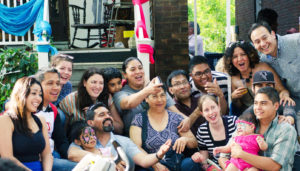
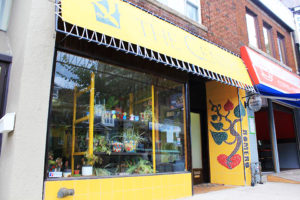
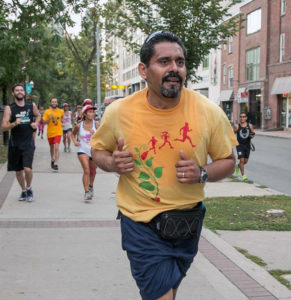
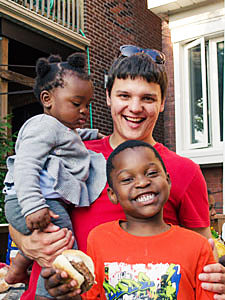






Hi Mary Jo Leddy:
I am interested in knowing more about the Romero. Can you send me your newsletters monthly? I am from Kitchener, Ontario. If I can go to Toronto for a visit, I’d like the drop in the House. What is your street address? I do volunteer work at the working centre tudoring TESOL. I also am a volunteer facilitator at a self help peer support group as well. I would love to hear more about the refugees. Hope to hear from your soon.
Mary Cole